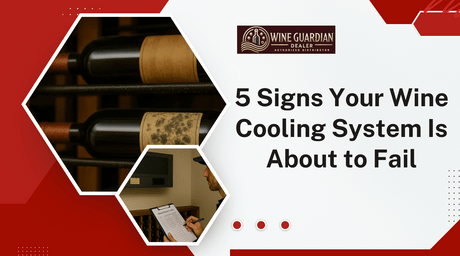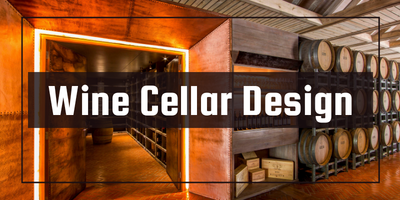
5 Signs Your Wine Cooling System Is About to Fail
Don’t wait for a costly surprise. Wine Guardian Dealer breaks down the top 5 signs your wine cooling system may be failing — and how to fix it before damage...
Jim Hopper
In Stock & Ready to Ship – Order Your Wine Cooling System Today!
Free Wine Cellar Expert Consultation | 📞 Call 1-800-260-1712
Start with a free expert consult—cooling system sizing, racking options, and no upsells.

Build your dream wine cellar—without costly mistakes or guesswork.
By Jim Hopper, Wine Cooling Expert
Choosing the right cooling unit is one of the most important steps in building a wine cellar. Get it wrong, and your system might underperform, overwork, or worse—let your wine spoil. Get it right, and your wine stays perfectly preserved year-round.
👉 Before you dive into sizing, check out our full Wine Cooling System Planning Guide to make sure you’ve covered every critical planning step — from insulation and system types to budgeting and humidity control.
So how do you size a wine cellar cooling system correctly? The cooling system of a wine refrigerator plays a pivotal role in preserving your wine collection, making proper sizing essential. Providing detailed wine cellar specifications helps ensure that the thermal loads are accurately estimated, guiding you in selecting the right cooling solutions for your specific cellar requirements.
In this guide, we’ll break it down step-by-step:
Let’s get your wine cellar perfectly cooled.

BTU stands for British Thermal Unit, a measurement of how much energy your cooling system uses to remove heat from a room. The higher the BTU, the more powerful the cooling unit. All wine cooling units are designed to maintain specific temperature and humidity levels to preserve wine quality.
In wine storage, BTUs determine:
Too few BTUs? Your system runs constantly and wears out.
Too many BTUs? Your system cools too fast without controlling humidity.

To find the right unit, you’ll need to consider:
Let's start with the basics: Room Volume. This is the first step in determining the right cooling unit for your wine cellar. Think of it as the foundation upon which all your calculations are built. To figure this out, you'll need to multiply the Width, Length, and Height of your cellar. This gives you the Cubic Feet, which is a critical metric in sizing your system.
For example, imagine you have a cozy little cellar that's 10 feet wide, 12 feet long, and 8 feet high. By doing a quick calculation: 10 ft x 12 ft x 8 ft, you end up with 960 cubic feet. Easy, right? This number is your starting point and will guide you in selecting the right cooling system to ensure your precious wine collection is stored at the perfect temperature .
Remember, getting this measurement right is crucial. It’s like fitting the right shoe size; too small, and your feet hurt, too big, and you trip over. Similarly, an accurately sized cooling system ensures your wine ages gracefully, maintaining its quality over extended periods. So, grab that tape measure and start calculating your cellar's volume—it's the first step to creating the perfect environment for your wines to thrive!
When it comes to insulation, it's all about balance. The better your insulation, the fewer BTUs you'll need. Conversely, if your insulation leaves much to be desired, you'll have to ramp up those BTUs. Proper insulation in a wine cellar is crucial; it reduces the thermal load on your cooling system, ensuring it operates efficiently and maintains consistent conditions.
Let's break it down:
For a detailed guide on getting your insulation just right, check out our Wine Cellar Insulation Guide.
Remember, the key to a well-functioning wine cellar is finding that sweet spot where your insulation and cooling system work in harmony. It's like a dance, and when done right, it ensures your wine collection is preserved beautifully, allowing you to savor every sip!
Where your wine cellar is located within your home plays a significant role in determining the cooling system requirements. Think of it like this: just as a sunbather needs more sunscreen, a cellar in a warmer spot needs more cooling power. Here's how different locations impact the heat load:
|
Location |
Heat Load Impact |
|---|---|
|
Interior closet or basement |
Low |
|
First-floor room |
Medium |
|
Garage, attic, or sun-facing room |
High |
Interior Closets or Basements are tucked away from the hustle and bustle, offering a naturally cooler environment with minimal external heat interference. These spots are an excellent choice for a wine cellar, requiring less BTU capacity to maintain that all-important consistent temperature.
For a First-floor Room, the heat load is moderate. These rooms are a bit more exposed to the home's ambient conditions, so your cooling unit will need to work a bit harder, but it's still manageable.
Now, if you're considering a Garage, Attic, or Sun-facing Room, brace yourself for a high heat load. These areas are notorious for temperature swings and higher ambient temperatures. Your cooling system will need to pack a punch to keep your cherished wine collection at the perfect aging conditions.
Remember, the site and location of your wine cellar can significantly affect its cooling needs. So, choose wisely and plan accordingly to ensure your wine collection remains in optimal condition, ready for you to enjoy whenever the occasion calls!
More glass = more heat.
More lighting = more heat.
If your cellar has:
👉 Add 15–25% more BTU capacity.
The ambient temperature and the climate of your location significantly impact the cooling system's efficiency. If your wine cellar is situated in a region with high temperatures or drastic seasonal changes, it may require a more robust cooling unit to maintain a consistent temperature. For instance, wine cellars in desert climates or tropical areas might need additional BTUs to counteract the external heat.
Consider not only the current size of your wine collection but also its potential to grow over time. A larger collection absorbs more heat, impacting the cooling system’s performance. If you plan to expand your collection, opting for a cooling system with a higher capacity might be wise. This foresight will ensure that your cooling unit can handle the increased load without compromising on maintaining the ideal conditions for the aging process.
Humidity plays a crucial role in preserving wine quality. Excessive dryness can lead to cork shrinkage, while too much humidity can encourage mold growth. Ensure your cooling system can provide adequate humidity control, especially if your cellar is in a dry climate. Some systems come with integrated humidifiers or can be paired with standalone units to maintain the optimal humidity range of 60–70%.
✅ 8. Energy Efficiency and Operational Costs
Energy efficiency is a vital factor when selecting a wine cooler or wine cellar cooling system. An energy-efficient unit not only reduces operational costs but also minimizes environmental impact. Look for systems with high R-value insulation and energy-saving features to ensure your wine cellar remains both cost-effective and eco-friendly. Investing in a quality system initially can lead to significant savings over the extended periods of operation.
Learn more about costs in How Much Does a Wine Cooling System Really Cost?.
Modern cooling systems are an excellent choice, offering a range of features that enhance their performance and user experience. Consider units with advanced monitoring systems, remote control capabilities, and customizable settings. These features allow you to tailor the system’s operation to your specific needs, ensuring the wine cellar remains at the perfect temperature and humidity levels. Additionally, some systems are designed to operate quietly, preventing any disturbance to the ambiance of your wine cellar.

|
Cellar Size (Cubic Feet) |
Recommended BTUs |
Wine Guardian Options |
|---|---|---|
|
300–650 cu ft |
2,000–3,500 BTU |
Wine Wall WG25 or D025 |
|
650–1,200 cu ft |
4,000–6,000 BTU |
|
|
1,200–2,000 cu ft |
6,500–8,000 BTU |
|
|
2,000+ cu ft |
9,000+ BTU |
Note: Actual BTU needs vary based on insulation and climate.
Remember: You need cubic feet, not square feet. Understanding the full volume of your wine cellar is crucial because it directly impacts the cooling capacity required. A miscalculation here can lead to inadequate cooling, affecting the preservation of your wine collection.
Garages, attics, and west-facing rooms need more power—even if the size is small. The site and location of your wine cellar can significantly affect its cooling needs due to variations in ambient temperature and sunlight exposure. A cellar situated in a sun-facing room or an uninsulated space may require a more robust cooling unit to maintain a consistent temperature.
Even a small room can require a large system if poorly sealed. Proper insulation is vital to prevent heat exchange between your wine cellar and its surroundings. Without adequate insulation, your cooling system will have to work harder to maintain the desired conditions, leading to higher energy consumption and potential system strain.
Too much power = rapid cooling = poor humidity control = dry corks. While it might seem beneficial to have a more powerful system, oversizing can lead to rapid temperature fluctuations and inadequate humidity control. This can dry out corks, allowing air to seep into bottles and spoil the wine. It’s essential to balance the system’s power with the cellar’s specific needs to ensure optimal aging conditions for your wine collection.
Choosing the right wine cooling system depends on where your cellar is located, how it's built, and how much space you're working with. Below is a breakdown of common wine cellar locations and the best Wine Guardian system type for each.
Stable conditions, minimal external heat load.
✅ Recommended System:
Ducted Cooling Systems – Sentinel Series
Popular Models:
Compact space, limited airflow options.
✅ Recommended System:
Wine Wall Cooling Systems
Popular Model:
Wine Guardian WG25
Unconditioned space with major temp swings.
✅ Recommended System:
Split Cooling Systems – Pro Series
Popular Models:
Extreme temperature fluctuations, limited ceiling access.
✅ Recommended System:
Pro Series Ducted Split Systems
Stylish display space often with glass doors and lighting.
✅ Recommended System:
Wine Wall Cooling Systems
Popular Choice:
Wine Guardian WG40 Wine Wall System
High capacity, long-term storage, or hospitality projects.
✅ Recommended System:
High-Capacity Sentinel Series or Dual System Configurations
Top Performer:
Sentinel Series D200
✅ Recommended System:
Self-Contained Through-the-Wall Units (if available)
“We thought we needed a small system, but our garage location made things tricky. Wine Guardian helped us size it perfectly —55°F all year.”
— Mark S., Scottsdale, AZ
“I had no idea insulation made such a big difference. The team helped us get the right BTUs, and our split system has worked flawlessly.”
— Kim R., Dallas, TX
“We were worried about humidity with a larger unit, but the Wine Guardian team paired it with a humidifier—problem solved.”
— Julian P., Miami, FL
The right system makes all the difference. If you’re unsure about BTUs, room volume, or what unit fits your space, we’ve got you covered. All Wine Guardian cooling systems are made in the USA and come with a two year factory warranty.
👉 Shop Wine Guardian Cooling Systems
Explore wall-mounted, ducted, and split systems by cellar size.
📞 Call 1 (800) 260-1712 for a FREE sizing consultation
Our team will calculate your cooling needs and recommend the perfect solution—no guesswork required.
Multiply width x length x height to get cubic feet.
No—these units don’t offer precise humidity or temperature control for wine.
Estimate and round up. Always plan for more BTUs if in doubt.
Yes. Oversized systems cool too quickly and dry out the air, which harms corks and wine.
If you live in a dry climate or use a large system, yes. Wine Guardian Humidifiers keep RH in the 60–70% sweet spot.
🛒Shop our most-loved Wine Guardian cooling systems today.
🛠️Protect your wine with the most trusted systems on the market.
❤️Tested, reviewed, and loved by serious collectors like you.